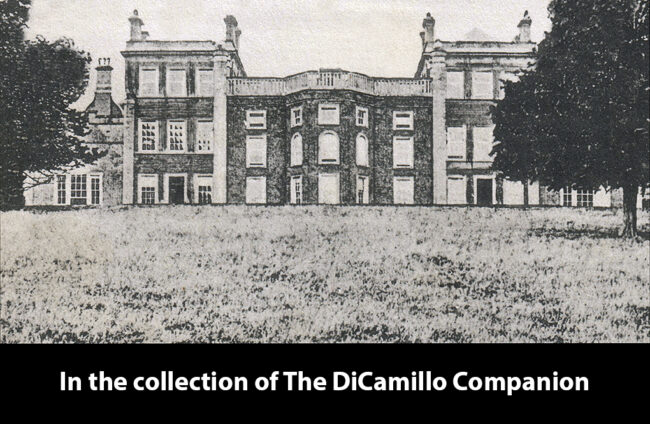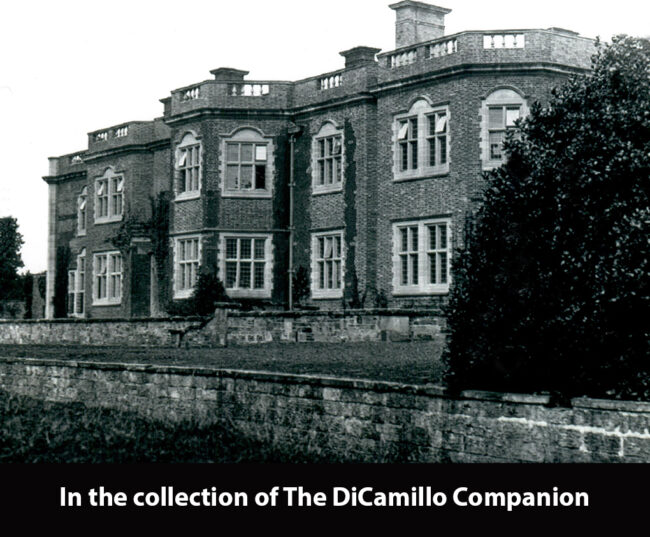
The House from a 1907 postcard

The House from a circa 1910 postcard
House & Family History: The Pallinsburn Estate was created by the Askew family between 1763 and 1813. In 1911 the property was sold by the Askews to Major Charles Mitchell, grandson of the founder of the Low Walker Shipyard, and the son of artist Charles William Mitchell. In 1921 Major Mitchell reconstructed the house, with no regard for expense, after his marriage to Hope Hamilton. The Mitchell family, who also built Jesmond Towers in Newcastle, were partners of business tycoon Lord Armstrong, owner of Bamburgh Castle and builder of famous Cragside House. In 2004, after the death of Colonel Charles Mitchell, the Pallinsburn Estate was sold for £6.5 million.
Collections: Lyon & Turnbull auctioned the contents of the House on May 4, 2005. The contents of Pallinsburn included a number of important items from Sundrum Castle, including furniture, pictures, books, many important Scottish Georgian pieces, and a set of archives which trace the redesign of the Castle by John Patterson in 1798 (Sundrum Castle was owned by the Hamilton family, whose youngest daughter, Hope, was Charles Mitchell's mother). Included in the sale was an important Ziegler carpet, portraits of the Hamilton family and of James Boswell of Auchinleck (a neighbor at Sundrum), and a set of 12 Brander back Scottish dining chairs from Sundrum Castle. Hope Hamilton also brought with her a great number of items from her relative's seafaring days, including the complete logbooks of her grandfather, Captain John Hamilton, who captured four canons from the French frigate "The Medee" on August 5, 1800. The Hamiltons made their money from the China Trade, in addition to owning a sugar plantation in Jamaica. When clearing out the Granary, the complete record of the Sundrum Estate, along with the logbooks, diaries, and a sea chest belonging to Captain John Hamilton, were discovered. Items in the sea chest were still wrapped in paper dated 1805. The star of the sale, however, was a unique sketch book (or codex), circa 1520s, purchased by London-based collector Sam Fogg and linked to Renaissance artist Raphael, which sold for £230,000 (against an estimate of £50,000). The sketches were drawn by Giovanni Battista da San Gallo, a younger brother of Raphael's chief assistant in building St. Peter's Basilica in Rome from 1516. Professor Ian Campbell, an authority on Roman architectural drawing at Edinburgh College of Art, said: "Giovanni Battista could have done these drawings for Raphael and they probably give us a better impression of what Raphael intended than anything else. The book was last recorded in the 18th century in the library of Baron Philip de Stosch, a celebrated collector who was also an English spy who reported on the whereabouts of the Old Pretender in Rome. His library was sold in 1764 with most of the architectural drawings ending up in The Albertina - the drawings collection of the Vienna State Museum. The codex however was not included in the sale and disappeared for over 200 years, only to resurface in the Library at Pallinsburn House." The Pallinsburn Codex was purchased by the Royal Institute of British Architects and is now in its collection in London. The sale of the contents of Pallinsburn was the largest country house sale from the Northeast of England since the dispersal of the contents of Callaly Castle by Christie's on September 22-24, 1986.
Garden & Outbuildings: In 2005 the House was surrounded by a 1,502-acre Estate.
House Listed: Grade II*
Park Listed: Not Listed
Past Seat / Home of: Askew family, 1763-1911. Colonel Charles Mitchell and his wife, Jane Lyell, 20th century.
Current Ownership Type: Individual / Family Trust
Primary Current Ownership Use: Private Home
House Open to Public: No
Historic Houses Member: No